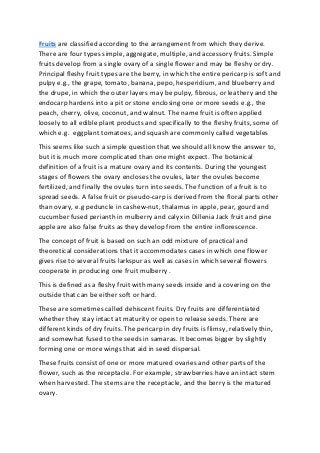
Different types Of fruits names.pdf
- 1. Fruits are classified according to the arrangement from which they derive. There are four types simple, aggregate, multiple, and accessory fruits. Simple fruits develop from a single ovary of a single flower and may be fleshy or dry. Principal fleshy fruit types are the berry, in which the entire pericarp is soft and pulpy e.g., the grape, tomato, banana, pepo, hesperidium, and blueberry and the drupe, in which the outer layers may be pulpy, fibrous, or leathery and the endocarp hardens into a pit or stone enclosing one or more seeds e.g., the peach, cherry, olive, coconut, and walnut. The name fruit is often applied loosely to all edible plant products and specifically to the fleshy fruits, some of which e.g. eggplant tomatoes, and squash are commonly called vegetables This seems like such a simple question that we should all know the answer to, but it is much more complicated than one might expect. The botanical definition of a fruit is a mature ovary and its contents. During the youngest stages of flowers the ovary encloses the ovules, later the ovules become fertilized, and finally the ovules turn into seeds. The function of a fruit is to spread seeds. A false fruit or pseudo-carp is derived from the floral parts other than ovary, e.g peduncle in cashew-nut, thalamus in apple, pear, gourd and cucumber fused perianth in mulberry and calyx in Dillenia Jack fruit and pine apple are also false fruits as they develop from the entire inflorescence. The concept of fruit is based on such an odd mixture of practical and theoretical considerations that it accommodates cases in which one flower gives rise to several fruits larkspur as well as cases in which several flowers cooperate in producing one fruit mulberry . This is defined as a fleshy fruit with many seeds inside and a covering on the outside that can be either soft or hard. These are sometimes called dehiscent fruits. Dry fruits are differentiated whether they stay intact at maturity or open to release seeds. There are different kinds of dry fruits. The pericarp in dry fruits is flimsy, relatively thin, and somewhat fused to the seeds in samaras. It becomes bigger by slightly forming one or more wings that aid in seed dispersal. These fruits consist of one or more matured ovaries and other parts of the flower, such as the receptacle. For example, strawberries have an intact stem when harvested. The stems are the receptacle, and the berry is the matured ovary.